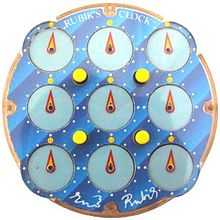Rubik's Clock

Rubik's Clock is a mechanical puzzle invented and patented by Christopher C. Wiggs and Christopher J. Taylor.[1] The Hungarian sculptor and professor of architecture Ernő Rubik bought the patent from them to market the product under his name. It was first marketed in 1988.
Rubik's Clock is a two-sided puzzle, each side presenting nine clocks to the puzzler. There are four wheels, one at each corner of the puzzle, each allowing the corresponding corner clock to be rotated directly. (The corner clocks, unlike the other clocks, rotate on both sides of the puzzle simultaneously and can never be operated independently. Thus the puzzle contains only 4 independent clocks.)
There are also four buttons which span both sides of the puzzle; each button arranged such that if it is "in" on one side it is "out" on the other. The state of each button (in or out) determines whether the adjacent corner clock is mechanically connected to the three other adjacent clocks on the front side or on the back side: thus the configuration of the buttons determines which sets of clocks can be turned simultaneously by rotating a suitable wheel.
The aim of the puzzle is to set all nine clocks to 12 o'clock (straight up) on both sides of the puzzle simultaneously.
It is actually very easy to solve this puzzle. One reason for this is that unlike (for example) Rubik's Cube, the Clock is a commutative puzzle: the order in which operations are done does not matter. (This is true provided we understand "operation" to mean an action of "setting the buttons and then rotating a wheel"—of course individual button moves do not commute with wheel moves.) Consequently a complete mathematical solution can be obtained merely using techniques of linear algebra without involving the subject of group theory which is often required in sequential move puzzles.[citation needed]
The current world record for solving the puzzle as quickly as possible is held by Sam Zhixiao Wang (王志骁), with a time of 5.27 seconds single, set at Shanghai Winter 2011.[2] The record of best average of 5 with an average of 6.79 seconds is held by Evan Liu, done at World Championships 2013.[3]
See also
- Mechanical puzzles
- Combination puzzles
References
- ↑ Patents EP0322085 (1989-06-28), JP1171588 (1989-07-06), GB2213739 (1989-08-23), US4869506 (1989-09-26)
- ↑ World Cube Association - Rubik's Clock Best Single
- ↑ World Cube Association - Rubik's Clock Best Average
External links
- Rubik's Clock Solution An illustrated description of the solution.
- Unofficial Records Speedcubing.com's page of unofficial records for the Rubik's Clock
- Online Rubik's Game (Official) Official Flash version of Rubik's Clock
- Real Genius Computer game implementation of Rubik's Clock for the Commodore Amiga, released in 1989
| ||||||||||||||||||||||||||||||||||||||||||||||||||||||||||||